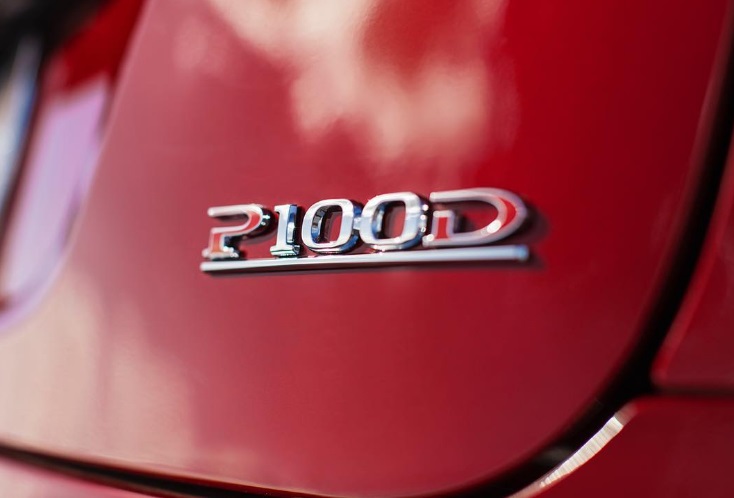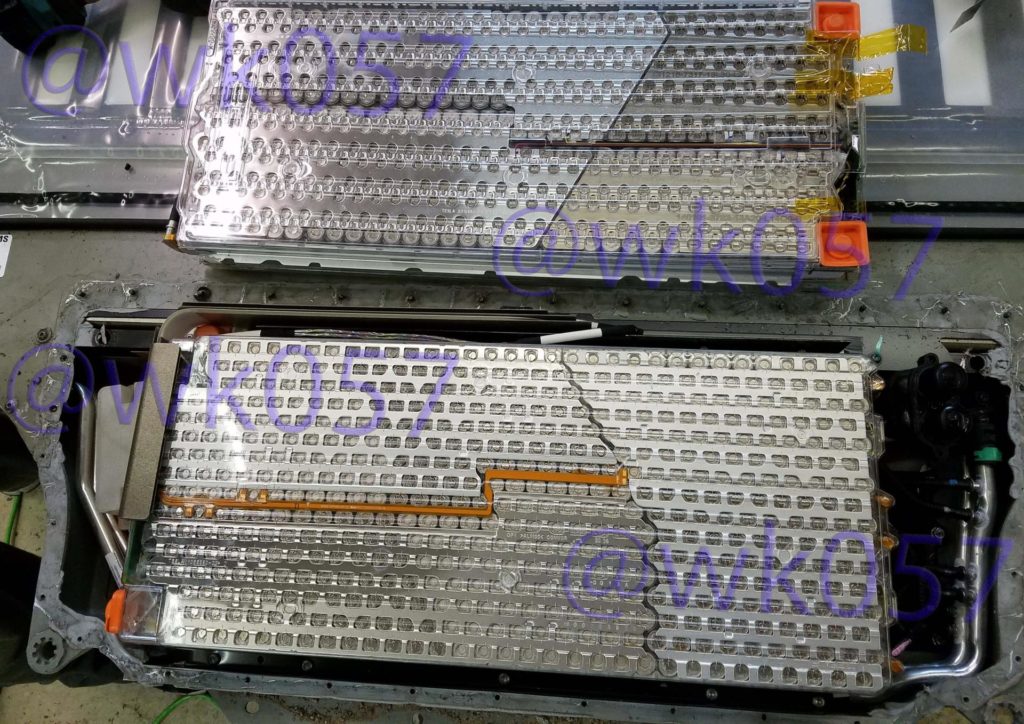News
An inside look at Tesla’s P100D battery pack: more cells, 102 kWh capacity, backwards compatibility in mind

New details of Tesla’s mysterious P100D battery pack, which Tesla CTO JB Straubel once described as having notable changes in battery module and pack technology, and a “complete redo on the cooling architecture”, have emerged thanks to Jason Hughes’s latest project.
Hughes posted photos of a dismantled 100 kWh battery pack, which he obtained through the purchase of a salvaged Tesla P100D, that reveal an increase in the number of 18650 lithium-ion cells being packed within each battery module. Hughes also discovered a surprising increase in battery capacity beyond 100 kWh, and what appears to be a replaceable connector that allows Tesla to retrofit older vehicles with the newer battery pack.
More 18650 Battery Cells
As outlined in Hughes’s blog post, Tesla was able to fit more of its cylindrical 18650 lithium-ion battery cells into each of the 16 modules making up the P100D battery pack. It’s worth noting that Tesla has maintained a relatively similar form factor on battery packs produced for Model S and Model X vehicles since their introduction. Regardless of the vehicle’s model version – be it a P85, a 60, 75D, or 90D – the uniform skateboard design of the battery pack allows for ease of production, as Tesla can manufacture a single-style pack that can be installed across its fleet of vehicles. Under that same notion, Tesla has also been able to create ‘unlockable features’ by software limiting vehicle range depending on the option purchased by the customer. In other words, Tesla installs the same battery pack into like-kind vehicles (e.g. Model S 60 uses the same pack as Model S 75).

Tesla P85 battery pack module vs. P100D module [Credit: Jason Hughes via @wk057]
Hughes’s dissection of the P100D battery shows that Tesla leveraged the same design concept by distributing a total of 8,256 battery cells across the 16 modules making up the battery pack, bringing total capacity up to the advertised 100 kWh number. However, and much to Hughes’s surprise – he had previously criticized Tesla for providing less battery capacity than what’s perceived by way of the vehicle’s nameplate – Tesla actually provided 102.4 kWh of capacity on the P100D pack, representing a 2.4% increase over what’s marketed.
Backwards Compatible Design
Tesla has also, seemingly, taken into account the ability to retrofit new battery packs onto older vehicles by using the same high and low-voltage connectors across packs. According to Hughes, “the pack itself has the same high-voltage connection, the same low voltages connectors, and the same cooling connector.” However, Hughes notes that there’s subtle changes on the P100D pack that would require a new part in order for it to be retrofittable onto non-P100D vehicles.
“The [P100D] pack has the newer ring around the high-voltage connector. So, it’s plug-and-play (for the most part, firmware and config changes needed) on the Model X and refreshed Model S, however it would require a different spacer ring on the high voltage connector. Tesla even has a part number for it, so it should be pretty simple to put into any Model S/X.” says Hughes.
What about that new P100D battery cooling architecture?
Well. It’s not magic. Tesla did improve battery cooling in the new P100D 100 kWh battery pack. And Tesla did provide a redone architecture, but it isn’t one of mythical proportions.
Hughes reveals Tesla’s approach to improve battery pack cooling was to use shorter and thinner cooling loops per battery module, thereby improving the rate of heat dissipation. Unlike most other electric car makers who do not “prime” their vehicle’s batteries through the use of a thermal management system, Tesla pumps fluid through the battery module to regulate the temperature of its battery pack in order to bring them to optimal operating temperatures. By ensuring the lithium-ion cells operate within ideal temperatures, Tesla is able to provide the best performance possible, while ensuring cell longevity.

Tesla P100D battery module cooling loops [Credit: Jason Hughes]

News
Nvidia CEO Jensen Huang explains difference between Tesla FSD and Alpamayo
“Tesla’s FSD stack is completely world-class,” the Nvidia CEO said.

NVIDIA CEO Jensen Huang has offered high praise for Tesla’s Full Self-Driving (FSD) system during a Q&A at CES 2026, calling it “world-class” and “state-of-the-art” in design, training, and performance.
More importantly, he also shared some insights about the key differences between FSD and Nvidia’s recently announced Alpamayo system.
Jensen Huang’s praise for Tesla FSD
Nvidia made headlines at CES following its announcement of Alpamayo, which uses artificial intelligence to accelerate the development of autonomous driving solutions. Due to its focus on AI, many started speculating that Alpamayo would be a direct rival to FSD. This was somewhat addressed by Elon Musk, who predicted that “they will find that it’s easy to get to 99% and then super hard to solve the long tail of the distribution.”
During his Q&A, Nvidia CEO Jensen Huang was asked about the difference between FSD and Alpamayo. His response was extensive:
“Tesla’s FSD stack is completely world-class. They’ve been working on it for quite some time. It’s world-class not only in the number of miles it’s accumulated, but in the way it’s designed, the way they do training, data collection, curation, synthetic data generation, and all of their simulation technologies.
“Of course, the latest generation is end-to-end Full Self-Driving—meaning it’s one large model trained end to end. And so… Elon’s AD system is, in every way, 100% state-of-the-art. I’m really quite impressed by the technology. I have it, and I drive it in our house, and it works incredibly well,” the Nvidia CEO said.
Nvidia’s platform approach vs Tesla’s integration
Huang also stated that Nvidia’s Alpamayo system was built around a fundamentally different philosophy from Tesla’s. Rather than developing self-driving cars itself, Nvidia supplies the full autonomous technology stack for other companies to use.
“Nvidia doesn’t build self-driving cars. We build the full stack so others can,” Huang said, explaining that Nvidia provides separate systems for training, simulation, and in-vehicle computing, all supported by shared software.
He added that customers can adopt as much or as little of the platform as they need, noting that Nvidia works across the industry, including with Tesla on training systems and companies like Waymo, XPeng, and Nuro on vehicle computing.
“So our system is really quite pervasive because we’re a technology platform provider. That’s the primary difference. There’s no question in our mind that, of the billion cars on the road today, in another 10 years’ time, hundreds of millions of them will have great autonomous capability. This is likely one of the largest, fastest-growing technology industries over the next decade.”
He also emphasized Nvidia’s open approach, saying the company open-sources its models and helps partners train their own systems. “We’re not a self-driving car company. We’re enabling the autonomous industry,” Huang said.
Elon Musk
Elon Musk confirms xAI’s purchase of five 380 MW natural gas turbines
The deal, which was confirmed by Musk on X, highlights xAI’s effort to aggressively scale its operations.

xAI, Elon Musk’s artificial intelligence startup, has purchased five additional 380 MW natural gas turbines from South Korea’s Doosan Enerbility to power its growing supercomputer clusters.
The deal, which was confirmed by Musk on X, highlights xAI’s effort to aggressively scale its operations.
xAI’s turbine deal details
News of xAI’s new turbines was shared on social media platform X, with user @SemiAnalysis_ stating that the turbines were produced by South Korea’s Doosan Enerbility. As noted in an Asian Business Daily report, Doosan Enerbility announced last October that it signed a contract to supply two 380 MW gas turbines for a major U.S. tech company. Doosan later noted in December that it secured an order for three more 380 MW gas turbines.
As per the X user, the gas turbines would power an additional 600,000+ GB200 NVL72 equivalent size cluster. This should make xAI’s facilities among the largest in the world. In a reply, Elon Musk confirmed that xAI did purchase the turbines. “True,” Musk wrote in a post on X.
xAI’s ambitions
Recent reports have indicated that xAI closed an upsized $20 billion Series E funding round, exceeding the initial $15 billion target to fuel rapid infrastructure scaling and AI product development. The funding, as per the AI startup, “will accelerate our world-leading infrastructure buildout, enable the rapid development and deployment of transformative AI products.”
The company also teased the rollout of its upcoming frontier AI model. “Looking ahead, Grok 5 is currently in training, and we are focused on launching innovative new consumer and enterprise products that harness the power of Grok, Colossus, and 𝕏 to transform how we live, work, and play,” xAI wrote in a post on its website.
Elon Musk
Elon Musk’s xAI closes upsized $20B Series E funding round
xAI announced the investment round in a post on its official website.

xAI has closed an upsized $20 billion Series E funding round, exceeding the initial $15 billion target to fuel rapid infrastructure scaling and AI product development.
xAI announced the investment round in a post on its official website.
A $20 billion Series E round
As noted by the artificial intelligence startup in its post, the Series E funding round attracted a diverse group of investors, including Valor Equity Partners, Stepstone Group, Fidelity Management & Research Company, Qatar Investment Authority, MGX, and Baron Capital Group, among others.
Strategic partners NVIDIA and Cisco Investments also continued support for building the world’s largest GPU clusters.
As xAI stated, “This financing will accelerate our world-leading infrastructure buildout, enable the rapid development and deployment of transformative AI products reaching billions of users, and fuel groundbreaking research advancing xAI’s core mission: Understanding the Universe.”
xAI’s core mission
Th Series E funding builds on xAI’s previous rounds, powering Grok advancements and massive compute expansions like the Memphis supercluster. The upsized demand reflects growing recognition of xAI’s potential in frontier AI.
xAI also highlighted several of its breakthroughs in 2025, from the buildout of Colossus I and II, which ended with over 1 million H100 GPU equivalents, and the rollout of the Grok 4 Series, Grok Voice, and Grok Imagine, among others. The company also confirmed that work is already underway to train the flagship large language model’s next iteration, Grok 5.
“Looking ahead, Grok 5 is currently in training, and we are focused on launching innovative new consumer and enterprise products that harness the power of Grok, Colossus, and 𝕏 to transform how we live, work, and play,” xAI wrote.









